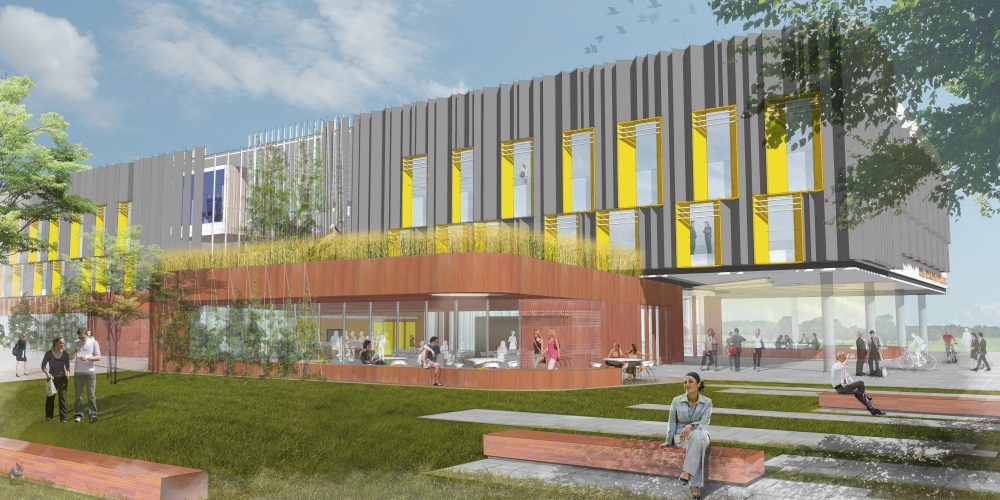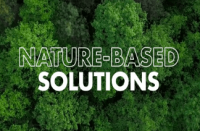It’s not every day that a building plan seeks input from an associate professor in community psychology. But then again, this is not an everyday building.
For one thing, it has ambitious goals to hit top benchmarks for net-positive commercial construction. The building, with about 115 square feet on three floors, is expected to generate more energy than it uses, treat wastewater onsite, harvest rainwater and naturally purify its indoor air.
It’s not every day that a building plan seeks input from an associate professor in community psychology. But then again, this is not an everyday building.
For one thing, it has ambitious goals to hit top benchmarks for net-positive commercial construction. The building, with about 115 square feet on three floors, is expected to generate more energy than it uses, treat wastewater onsite, harvest rainwater and naturally purify its indoor air.
When it opens in 2018, the Waterloo, Ontario, building will not only house multiple tenants with aligned values, but it will also include an innovation hub, with an incubator supporting green economy and clean-tech concepts for startups, corporate partners and academia.
But the building, with a working title of Centre for Sustainability Excellence, is also unusual for its intriguing collaborations. The project leader is Sustainable Waterloo Region (SWR), which has a proven record in helping local organizations convert sustainability interest into action.
SWR’s partners for the project include The Cora Group (developer), David Johnston Research + Technology Park at the University of Waterloo (the landowner) and EY Canada, which will be an anchor tenant.
The planning process stretches beyond boardrooms. SWR believes many high-performance buildings don’t live up to their potential because the people-factor is not adequately considered in reaching performance targets through design and operation. So “citizens” connected to this building – everyone from the landlord to the tenants and even those just passing through – will play an important role.
And that’s where Dr. Manuel Riemer comes in. Riemer, Associate Professor of Community Psychology and the Director of the Centre for Community Research, Learning and Action at Wilfrid Laurier University in Waterloo, has a leading role in this project, engaging the building’s “citizens” in the sustainability strategy from start to finish. Additional research, including focus groups and surveys with prospective tenants and people working in the surrounding area, will also target key concerns and help tailor strategies to fit within existing organizational and social structures.
In other words, SWR not only envisions a building that will achieve ambitious performance targets, but also a behavioural model that supports a sense of belonging through authentic interactions between people of different backgrounds, skill sets and experience.
Along the way, SWR will consider how pride of place, values alignment, individual action and measureable results contribute to an overall sense of belonging. When people’s values align, it brings them together as a community.
This, in turn, feeds into SWR’s belief that sustainability is more achievable when people – both individuals and organizations – care about the collective well-being of the building, its surroundings and its other citizens. By building trusting, mutually beneficial relationships, each party “owns” the project.
Finding tenants who buy into the project’s collective values is an important part of the process. And early collaboration facilitates shared experience and seeds the cultural structure on which SWR’s goals are dependent. EY Canada is the perfect fit as an anchor tenant. Company officials have been working with SWR for years to reduce their environmental impact and have been heavily involved in planning the new building.
The vision for an innovation hub takes shared values and purposes to a new level, creating a sustainability ecosystem where people can pursue environmental innovation and research either independently or as part of a larger organization. Plans call for a 20,000-square-foot incubator plus a collaborative space that includes various types of workspaces and a 3,500-square-foot event space.
The research going into the overall plans for the building won’t stop once tenants move in and the innovation hub is active. As well as developing recommendations for building management, SWR will work with Riemer to explore how lasting sustainability habits are built.
The World Green Building Council reports that employees who work in buildings that prioritize both physical and psychological well-being are more productive. The same report states that sustainability happens at the “sweet spot” of good design, good technology and good behaviour. For the SWR project, the “good behavior” will come from engaged citizens who contribute to a positive, connected community.
“Individual well-being is not really just about individuals,” Riemer explains. “It requires group well-being, and to understand what that is, we must also consider the context of the situation. For [this building] to be sustainable, we need to find a way to achieve individual and group well-being.”
As Tova Davidson, Executive Director at Sustainable Waterloo Region, says: “Change starts with people. When people realize that they have the power to change the world, amazing things can happen, and we want the people in this building to feel that empowerment.”
As for the building itself, plans include a solar wall covering most of the south face of the building; a three-storey green wall and performance displays prominent in the atrium; solar panels covering the entire roof and a significant portion of the parking lot; permeable paving for hard surfaces; and green roofs.
To demonstrate its environmental impact, metrics will be tracked and shared publicly. With every action made, citizens contribute to the sustainability of the building, and measureable results will allow them to take ownership for their actions.
The building’s location in the David Johnston Research + Technology Park, part of the University of Waterloo’s North Campus, is also significant. This park, which has nine buildings housing more than 75 companies, has already created a community of belonging, which will be used as a strong foundation for the SWR project.
The park joined SWR’s Regional Carbon Initiative program in 2014 with a 40-per-cent greenhous gas reduction target across multiple buildings and multiple tenants. This commitment was set thanks to a cross-company green team, something that had never been done in the Regional Carbon Initiative. This is the same type of inter-organizational collaboration that the new building is striving to produce.
Carol Stewart, Business Development Manager of the R+T Park, says she is pleased that the building will be part of the R+T Park. “It strongly aligns with our environmental and cultural values and will be a great addition to the community we have created here.”
Sustainability is more attainable when people feel like they belong to a larger community. To make a real change, people have to alter their behaviour and habits, and there has to be innovation in the environmental sector.
Creating a strong sense of belonging in an environmentally forward community may start with SWR’s plans for this new building, but it doesn’t end there. It doesn’t end with Waterloo Region or Canada. It ends when everyone realizes that their actions are part of something much bigger, and that individuals play an important role in creating a shift in our society and for a more sustainable world.
Lexi Halley is the Public Relations Manager for Sustainable Waterloo Region. She has a history of dedicated volunteerism and deep roots within the Region.













